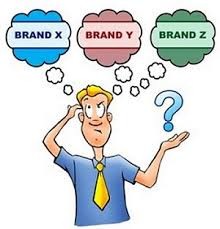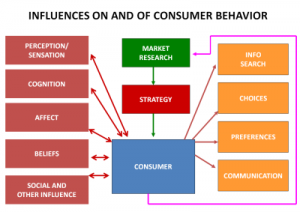In the marketing world where each day new brands are introduced and for any given product, list of substitutes are available, product positioning becomes a big challenge for marketers. Consumer behavior offers marketers an insight into the psyche of the consumers. Consumer behavior is an interdisciplinary area which has its concepts rooted in psychology, sociology and anthropology. Consumer Behavior handles two aspects of marketing: brand development and marketing communication. One of the biggest reality of marketing is consumer decisions are not completely comprehensible. Consumers are enigmatic; questions such as why, when, how topple marketing strategies to no end. Many times, why a product clicked or why some other product failed seems illogical. Every marketer attempts to please the c ustomers by ways and means that drives consumer’s buying decision. And, every marketer’s dream is to understand the psyche of the consumers. Marketers keep speculating and predicting the outcomes of their marketing campaigns. The branch of buyer behavior as a subject provides the synergy required to match the product and needs of consumers, which helps to develop brands using perception, to address buyer worries and to create a favorable attitude of customers.
ustomers by ways and means that drives consumer’s buying decision. And, every marketer’s dream is to understand the psyche of the consumers. Marketers keep speculating and predicting the outcomes of their marketing campaigns. The branch of buyer behavior as a subject provides the synergy required to match the product and needs of consumers, which helps to develop brands using perception, to address buyer worries and to create a favorable attitude of customers.
Few Buyer Behavior models are very useful to understand the concept:
The Economic Model: This model of consumer behavior suggests that people know all the facts that are relevant to a purchase. Consumers logically compare choices in terms of cost and value received to get the greatest satisfaction from spending their time and money. The Economic Model, one of the oldest models of Consumer Behavior tries to explain what a person is likely to buy and in what quantity. This model takes into consideration the behavior of an economic man which means a hypothetical person who behaves in exact accordance with his rational self-interest. Economic man gives foremost importance to the monetary or financial considerations while making a decision. The ultimate objective of an individual is the maximization of satisfaction by investing the minimum money resources for the satisfaction of his needs and wants. Though this model has certain limitations, it is one of the widely used models of consumer behavior. All students of marketing and business management must know this model.
Learning Model: This model suggests that a man gets information by learning and observing others. His core concepts are driven by stimulus, cues, responses and reinforcements which determine his needs and wants. Drive is a strong internal stimulus which compels action. This model is draws from Freudian psychology. It states that the individual consumer has some deep motives that drive him to make certain buying decisions. Observational learning occurs through observing the behavior of others. It is a form of social learning which takes various forms, based on various processes. In humans, this form of learning happens from childhood. The child observes his parents, siblings, teachers and neighbors in surroundings. Even as a person is growing, he/she educates to get more and more information.
The Sociological Model: According to the sociological model, the individual buyer behavior is influenced by society, close groups, social classes, population, income, castes, communities, family life cycle and other cultural aspects. The buying decisions of individuals are not totally based on utility; majority of buyers have a desire to follow the surroundings. Thus, as a part of sociological model the two important models are Nicosia model and Howard Sheth. A human being is analyzed as a system with stimuli as the input and behavior as the output of the system. The Nicosia model of buyer behavior was presented in 1966 by motivation and behavior expert Mr. Francesco Nicosia. The Howard Seth Model was presented in 1969 by John Howard and Jagdish Seth.
Psychoanalytical Model: This model draws from Freudian psychology. It states that the individual consumer has some deep motives that drive him to make certain buying decisions. The buyer has some hidden fears, hidden desires and subjective longings and personal wishes. His buying action can be affected by appealing to these desires. The psychoanalytical theory is credited to the work of noted psychologist Sigmund Freud. Freud introduced personality as a motivating factor in human behavior. According to this theory, the mental framework of a human being consists of three elements, namely: ID, ego and super ego. The id (or the instinctive or pleasure seeking element) is the group of inborn desires that a man is born with. It includes the aggressive, destructive and sexual drives of human. The superego (or the internal filter) presents to the individual the behavioral expectations of society. The ego (or the control device) maintains a balance between the id and the superego. The theory believes that a person is not able to satisfy all his needs within the boundaries of the society. These unsatisfied needs create tensions in an individual which have to be taken care of.
The Howard Sheth Model: This model serves as an incorporated framework for a very sophisticated comprehensive theory of consumer behavior. It should be noted that the authors John Howard and Jagdish Seth actually used the term buyer in their model to refer to industrial purchases as well as individual consumers. The model attempts to depict rational brand choice behavior by buyers under conditions of incomplete information and limited abilities. It distinguishes three levels of decision making:
- Extensive problem solving: this is an early stages of decision making in which the buyer has little information about brands and has not yet developed well defined and structured criteria by which to choose among the available products.
- Limited problem solving: This is more advanced stage; the choice criteria are well defined but the buyer is still unsure about which set of brands will best serve him. Thus, the consumer still experiences uncertainty about which brand is best.
- Routinized response behavior: Buyers have well defined choice criteria and also have strong tendency towards the brand. Little confusion exists in the consumer’s mind and he is ready to purchase a particular brand with little evaluation of alternatives. He is ready to take a chance.
Nicosia Model: This model explains the behaviour of the buyer by establishing a link between the organization & its prospective consumers. The model is based on the buyer’s responses to a stimulus (message) sent by a firm. A message from the firm first influences the predisposition of the consumer towards the product or service. Based on the prevailing situation the consumer will develop a certain attitude towards the product. This may result in a search for the product or the consumer may evaluate certain attributes of the product. If the consumer is satisfied, it may result in a positive response, with a decision to buy the product or the reverse may happen.
The decision-making process is divided into four areas:
- Consumer attitudes are shaped by information from the marketer. In this stage information flows from the sender (marketer) to the receivers (buyers).
- Consumer is always looking for information about specific category products and he assesses the information from various sources valuing his perspective. During the assessment the consumer allocates appropriate weight to each information piece. His choices of decisions are based on his viewpoints, they can many times be vague to describe. When the consumer gets satisfied with his analysis of a given product, he makes a decision of buying the product.
- At this stage consumer buys the product.
- Consumer experiences the purchase: he might or might not feel gratified. Based on his experience he tags his purchase as “good”, “bad”, “horrible,” or “overwhelming”. The last step is not only the consumption of a product but also a very important factor for the future decisions of the consumer. Feedback is also a very important factor for the company. Based on the feedback, the company prepares future product policy, its advertising and communications targeted to the consumer.














































